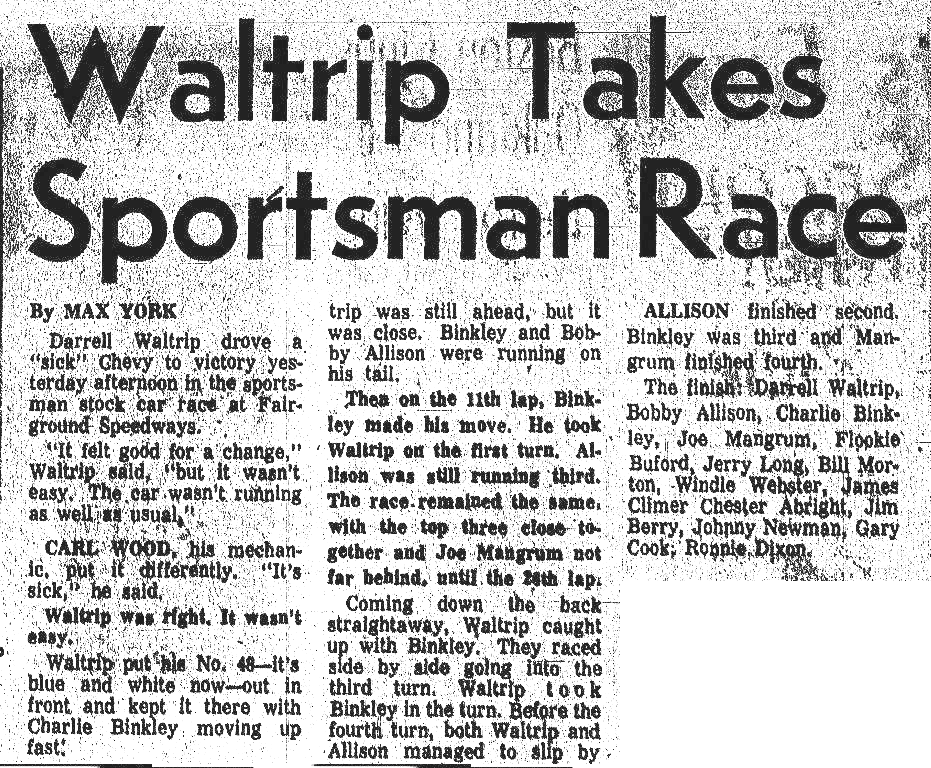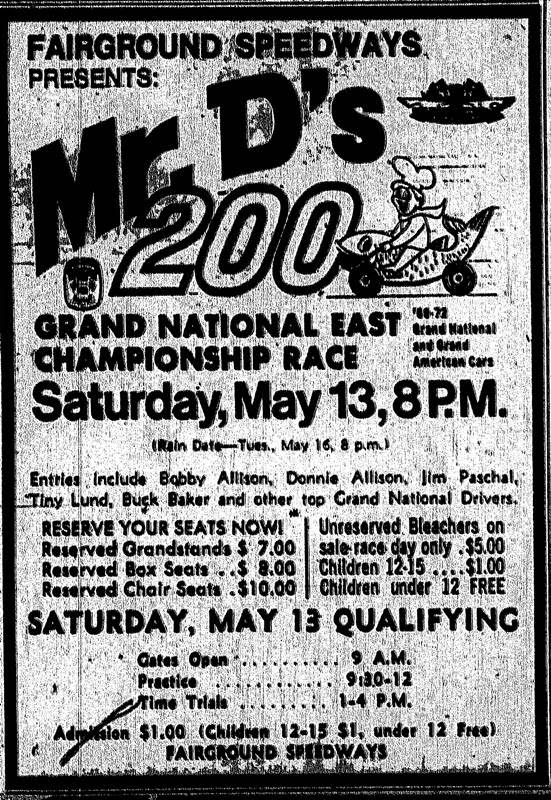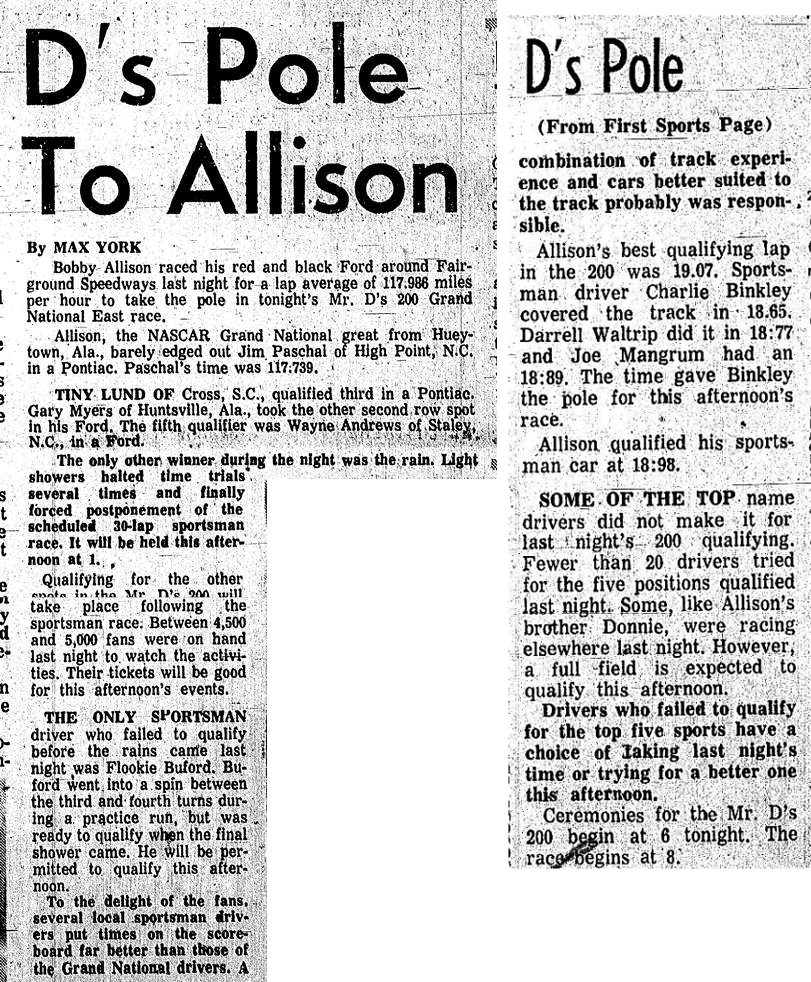Originally published as a blog post by me tonight. Thought I'd also post here.
http://bench-racing.blogspot.com/2014/05/may-13-1972-grand-national-east-at.html
From the 1960s through 1970, NASCAR's Grand National (Cup) schedule averaged about 50 races each season. In 1971, R.J. Reynolds climbed aboard, and the Winston Cup Series was born. The series had a transition year in 1971 with 48 races before dropping back to around 30 that became the staple until the mid 1990s.
When the schedule was dramatically slashed, many traditional tracks - particularly in the eastern time zone - lost their race dates. Perhaps as a way to ease their way out of relationship vs. leaving cold turkey, NASCAR formed the Grand National East series. The series only lasted for a couple of years; however, NASCAR later formed the Busch North Series in the mid 1980s to fill a similar role.
The series ran several tracks discarded from the Cup schedule such as Columbia, Hickory, Myrtle Beach and Kingsport. In 1972, the series ran the Mr. D's 200, its one and only event at a track that remained on the Cup schedule - Nashville Speedway.
Mr. D's was a fast food seafood restaurant created by the parent company of Shoney's restaurants. The chain's name was a nod to one of Shoney's founders, Ray Danner. Its first store was opened in Donelson, a suburb of Nashville, and happens to be where I grew up and lived from the late 1960s through the early 1980s.
Within a year or two of its opening, the name was changed to one more widely recognized today - Captain D's. I guess Cap'n had more of maritime, 'fishy' name than Mister. (For those unfamiliar with Captain D's, think Long John Silver.)
On Saturday May 13, 1972 - Mother's Day weekend - the GNE series raced at the Fairgrounds. The race was co-sanctioned with NASCAR's Grand American division, a series made up of pony cars such as Mustangs and Camaros.
 |
| Source: Russ Thompson - Nashville Fairgrounds blog |
Some of the drivers who entered the event were Winston Cup regulars - albeit independent drivers and/or those who weren't typically considered amongst the front runners. The field included such drivers as:
- Jim Paschal who raced Cup actively through much of the 1960s and won frequently as a driver for Petty Enterprises
- NASCAR HOFer Buck Baker whose heyday was in the 1950s when he won 2 GN titles
- D.K. Ulrich - long-time driver and owner for a multitude of up-and-comers including Al Loquasto
- Richard Childress who struggled for 15 years as a driver before striking gold as the owner for Dale Earnhardt
- Elmo Langley, a two-time GN winner who later became NASCAR's pace car driver
- Dick May - an independent who later became a rep for STP
- Wayne Andrews - a regular participant and winner in the Grand American series
- Tiny Lund, winner of the 1963 Daytona 500 and a multi-race winner in the GNE division.
- Cup regulars and brothers, Bobby and Donnie Allison
The Cup series raced on May 7th at Talladega but didn't run again until May 28th in the World 600 at Charlotte. Having a couple of weeks off gave some of the Cup regulars a chance to run the Nashville event (and presumably pocket a little show money from track promoter Bill Donoho).
Bobby Allison brought a #49 Coca-Cola Mustang Fastback to Nashville. The car was owned by Mel Joseph and had been raced in a few Grand National / Grand American combo races - including at Winston-Salem's Bowman Gray Stadium in 1971. Allison took the checkered flag over Richard Petty in the Mustang; however, NASCAR did not (and still doesn't) recognize the victory as an official Winston Cup win for Allison. (Interestingly, Petty wasn't given the win either.)
Perhaps as expected, Allison laid down the quickest lap to nab the pole. But the margin to second was maybe closer than he had counted as veteran Paschal showed he still knew the quick way around the track. (Paschal won three consecutive GN races at Nashville in 1961, [ 1962 ], and [ 1963 ]).
Darrell Waltrip, Nashville's 1970 late model champion, won the preliminary late model race. He won the short, 30-lap feature six days after making his Cup debut in the Winston 500 at Talladega. The fans were winners because some of the national drivers also raced in the late model event plus were out-qualified by many of the locals.
 |
| Source: The Tennessean - May 13, 1972 |
For a while, Waltrip raced P.B. Crowell's creamsicle orange-and-white #48 Chevelle. But in 1972 as a new sponsor came aboard, Waltrip's 48 sported a transitional white with blue accent scheme.
 |
| Credit: Russ Thompson |
Paschal had to give up his front-row starting spot after puking a motor in practice. Tiny Lund who was injured in a bizarre accident when a tire fell on him moved to the front row to take Paschal's vacated spot. With his injuries, however, his team made a driver swap at the first caution. Waltrip who'd won earlier in the day and obviously knew the track well took over for Tiny. (I am curious about how well Tiny's seat fit Waltrip back in those days!)
The Fairgrounds once had the oddest of pit roads. Drivers came through turn 4 on the .596-mile track, crossed the start-finish line, turned left onto the inner quarter-mile track, pitted, returned to the track, crossed the start-finish line again (though not completing another lap), and headed for turn 1. Drivers, officials and scorers were frequently confused as to who was on what lap, who had pitted, etc.
The confusion was present again during the GNE race. Rather than slow or stop the race to sort out things, officials let 'em race and tried to figure it out on the fly. As a result, the scoreboard was bouncing around with 'lead changes' though no passes were being made on the track.
Allison got out front about one-third of the way through the race. Waltrip tried to make the best of a good opportunity in Lund's car and did his best to track down Bobby. But after running like a scalded dog, Waltrip's car lost an engine with about 15 laps to go. Allison then cruised home to take the victory. Waltrip and Allison would wage many more battles over the next 10-12 years - especially in the early 80s on the Cup level.
 |
| Source: The Tennesseean - May 14, 1972 |
 |
| Courtesy of Russ Thompson |
As Russ Thompson [ noted in his blog post ], NASCAR apparently enjoyed what they saw at Nashville that weekend. Perhaps as a result, the track earned a second date on the Cup schedule. From 1973 through 1984, the Fairgrounds featured two races a season - a distinction several tracks didn't have, then or now.
I encourage you to visit [ GrandNationalEast.com ] authored by Jeff Droke, long-time crewman for James Hylton, for more information about the series.
--
Schaefer: It's not just for racing anymore.
updated by @tmc-chase: 12/05/16 04:00:58PM







